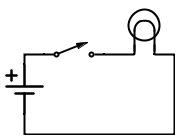Electric circuits, volts amps watts and ohms
Basic electrical theory every Restarter should know.
(This page is work in progress - comments and update suggestions to the Discussion page only for now please.)
Summary
A knowledge of basic electrical theory is essential for anything more than purely mechanical repairs, and will greatly help in diagnosing faults and working safely.
Electrical Circuits - doing the rounds
(Summary: Positive and negative charge. Opposite charges attract, like charges repel (pic), hence an open circuit results in a pile-up. A simple circuit - battery, switch, bulb (pic))
An atom consists of a very dense nucleus carrying a positive electric charge surrounded by a cloud of electrons, each having a negative electric charge. Normally, the positive and negative charges cancel exactly. Positive and negative charges attract one another, which keeps the electrons bound in an atom.
In a metal, some of the electrons are not tightly bound to any particular atom but are free to wander off, whilst the total of the positive and negative charges remain equal in the lump of metal as a whole. If these electrons move in a steady stream in one direction, e.g. along a piece of wire, we have an electric current.
Volts - the pressure is on
Low pressure - pic: thumb over inverted bottle of water?
High pressure - pic: Geneva Jet d'Eau.
Amps - go with the flow
Small flow - pic: dripping tap?
Large flow - pic: Amazon?
Watts - feel the power
Volts x Amps - large voltage or large current.
Illustrations?
Ohms - resistance isn't futile
Volts per amp
Illustration?
Safety
Consider whether your page should include a specific section on safety, if for example it deals with mains-powered equipment or high voltages, or if special care is required in handling hot or sharp tools, or hazardous substances.
References
External links
- External links as bullet points


